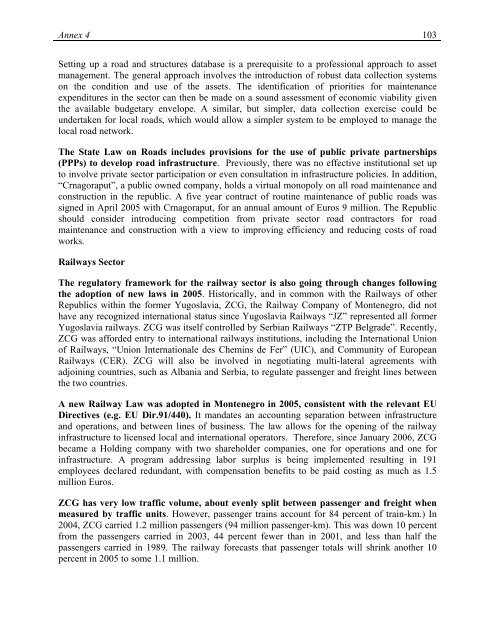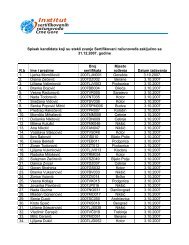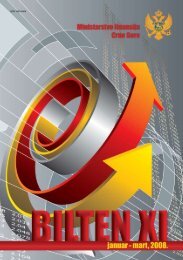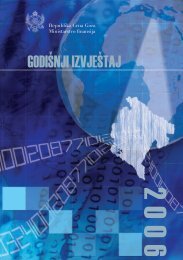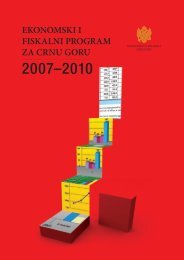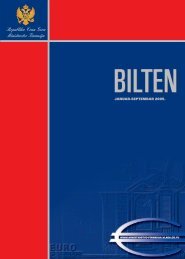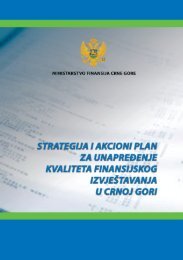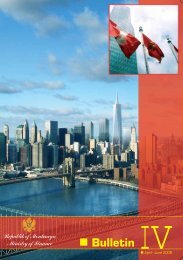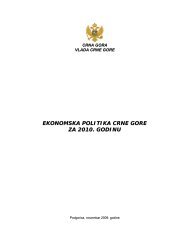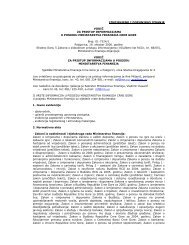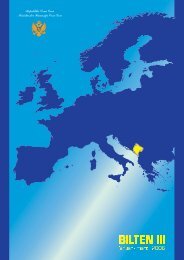Republic of Montenegro: Public Expenditure and ... - Vlada Crne Gore
Republic of Montenegro: Public Expenditure and ... - Vlada Crne Gore
Republic of Montenegro: Public Expenditure and ... - Vlada Crne Gore
You also want an ePaper? Increase the reach of your titles
YUMPU automatically turns print PDFs into web optimized ePapers that Google loves.
Annex 4 103<br />
Setting up a road <strong>and</strong> structures database is a prerequisite to a pr<strong>of</strong>essional approach to asset<br />
management. The general approach involves the introduction <strong>of</strong> robust data collection systems<br />
on the condition <strong>and</strong> use <strong>of</strong> the assets. The identification <strong>of</strong> priorities for maintenance<br />
expenditures in the sector can then be made on a sound assessment <strong>of</strong> economic viability given<br />
the available budgetary envelope. A similar, but simpler, data collection exercise could be<br />
undertaken for local roads, which would allow a simpler system to be employed to manage the<br />
local road network.<br />
The State Law on Roads includes provisions for the use <strong>of</strong> public private partnerships<br />
(PPPs) to develop road infrastructure. Previously, there was no effective institutional set up<br />
to involve private sector participation or even consultation in infrastructure policies. In addition,<br />
“Crnagoraput”, a public owned company, holds a virtual monopoly on all road maintenance <strong>and</strong><br />
construction in the republic. A five year contract <strong>of</strong> routine maintenance <strong>of</strong> public roads was<br />
signed in April 2005 with Crnagoraput, for an annual amount <strong>of</strong> Euros 9 million. The <strong>Republic</strong><br />
should consider introducing competition from private sector road contractors for road<br />
maintenance <strong>and</strong> construction with a view to improving efficiency <strong>and</strong> reducing costs <strong>of</strong> road<br />
works.<br />
Railways Sector<br />
The regulatory framework for the railway sector is also going through changes following<br />
the adoption <strong>of</strong> new laws in 2005. Historically, <strong>and</strong> in common with the Railways <strong>of</strong> other<br />
<strong>Republic</strong>s within the former Yugoslavia, ZCG, the Railway Company <strong>of</strong> <strong>Montenegro</strong>, did not<br />
have any recognized international status since Yugoslavia Railways “JZ” represented all former<br />
Yugoslavia railways. ZCG was itself controlled by Serbian Railways “ZTP Belgrade”. Recently,<br />
ZCG was afforded entry to international railways institutions, including the International Union<br />
<strong>of</strong> Railways, “Union Internationale des Chemins de Fer” (UIC), <strong>and</strong> Community <strong>of</strong> European<br />
Railways (CER). ZCG will also be involved in negotiating multi-lateral agreements with<br />
adjoining countries, such as Albania <strong>and</strong> Serbia, to regulate passenger <strong>and</strong> freight lines between<br />
the two countries.<br />
A new Railway Law was adopted in <strong>Montenegro</strong> in 2005, consistent with the relevant EU<br />
Directives (e.g. EU Dir.91/440). It m<strong>and</strong>ates an accounting separation between infrastructure<br />
<strong>and</strong> operations, <strong>and</strong> between lines <strong>of</strong> business. The law allows for the opening <strong>of</strong> the railway<br />
infrastructure to licensed local <strong>and</strong> international operators. Therefore, since January 2006, ZCG<br />
became a Holding company with two shareholder companies, one for operations <strong>and</strong> one for<br />
infrastructure. A program addressing labor surplus is being implemented resulting in 191<br />
employees declared redundant, with compensation benefits to be paid costing as much as 1.5<br />
million Euros.<br />
ZCG has very low traffic volume, about evenly split between passenger <strong>and</strong> freight when<br />
measured by traffic units. However, passenger trains account for 84 percent <strong>of</strong> train-km.) In<br />
2004, ZCG carried 1.2 million passengers (94 million passenger-km). This was down 10 percent<br />
from the passengers carried in 2003, 44 percent fewer than in 2001, <strong>and</strong> less than half the<br />
passengers carried in 1989. The railway forecasts that passenger totals will shrink another 10<br />
percent in 2005 to some 1.1 million.


